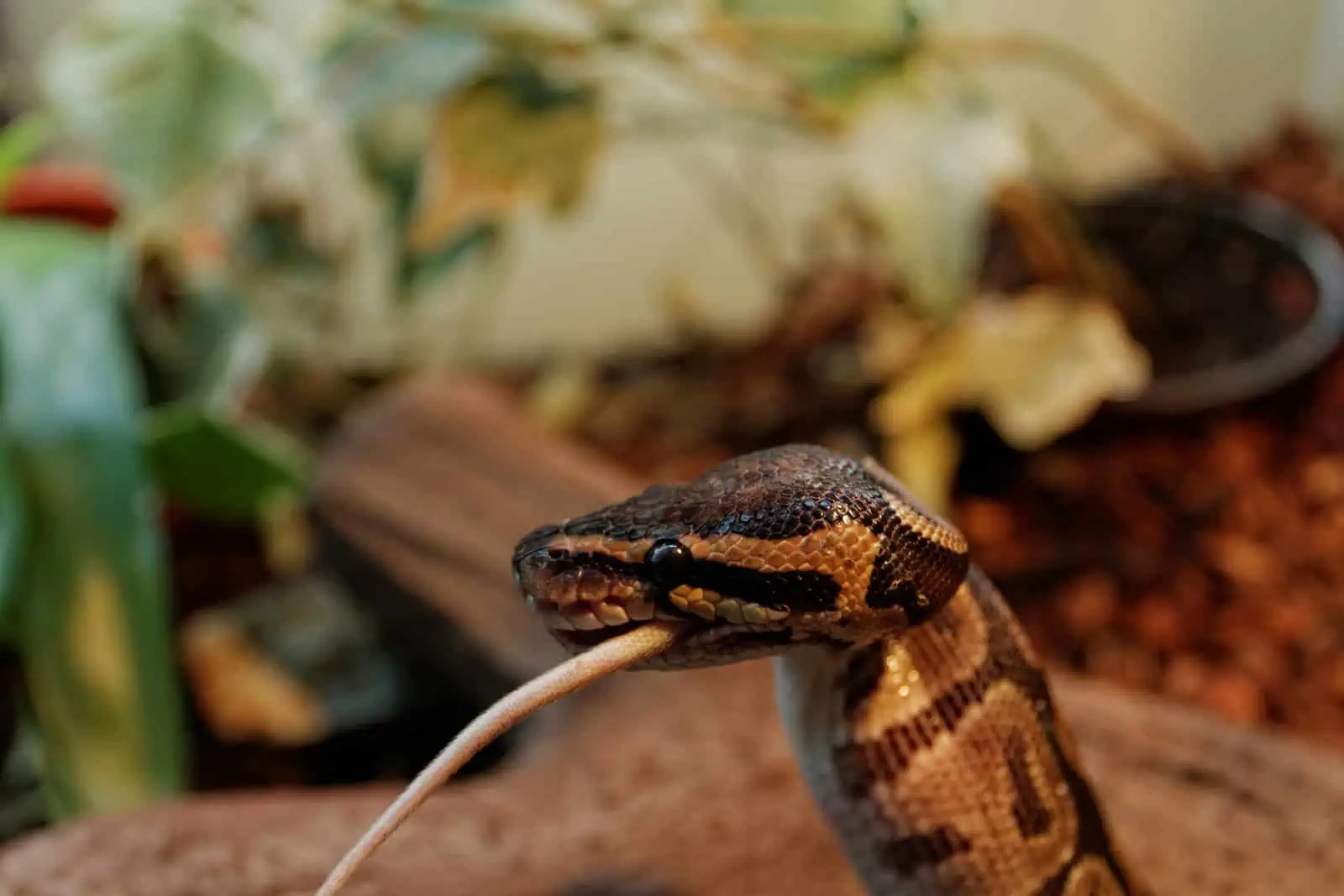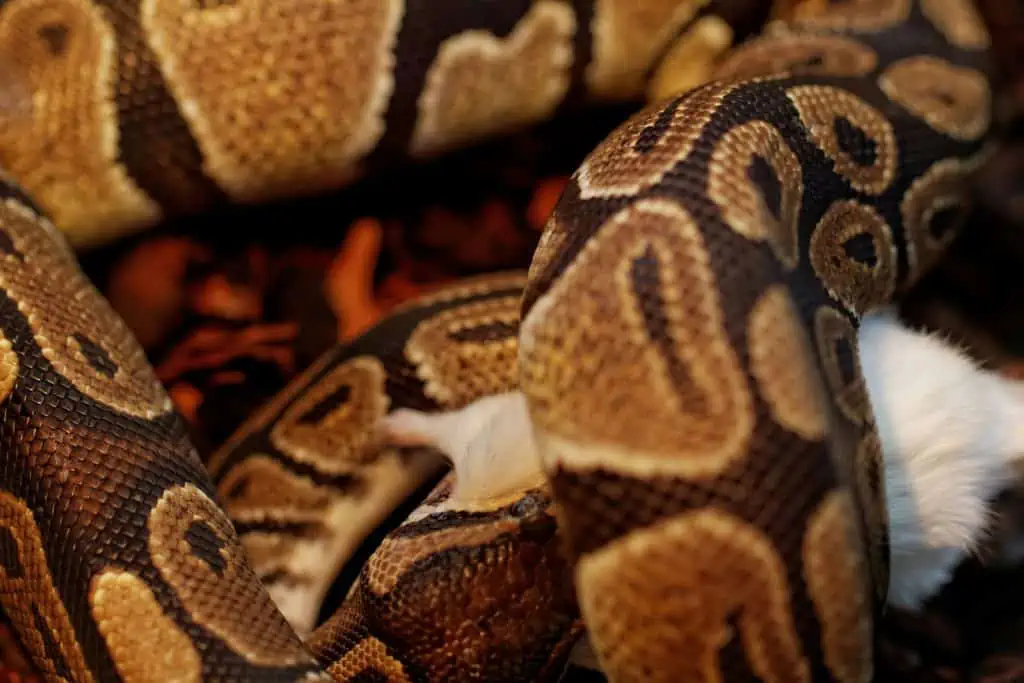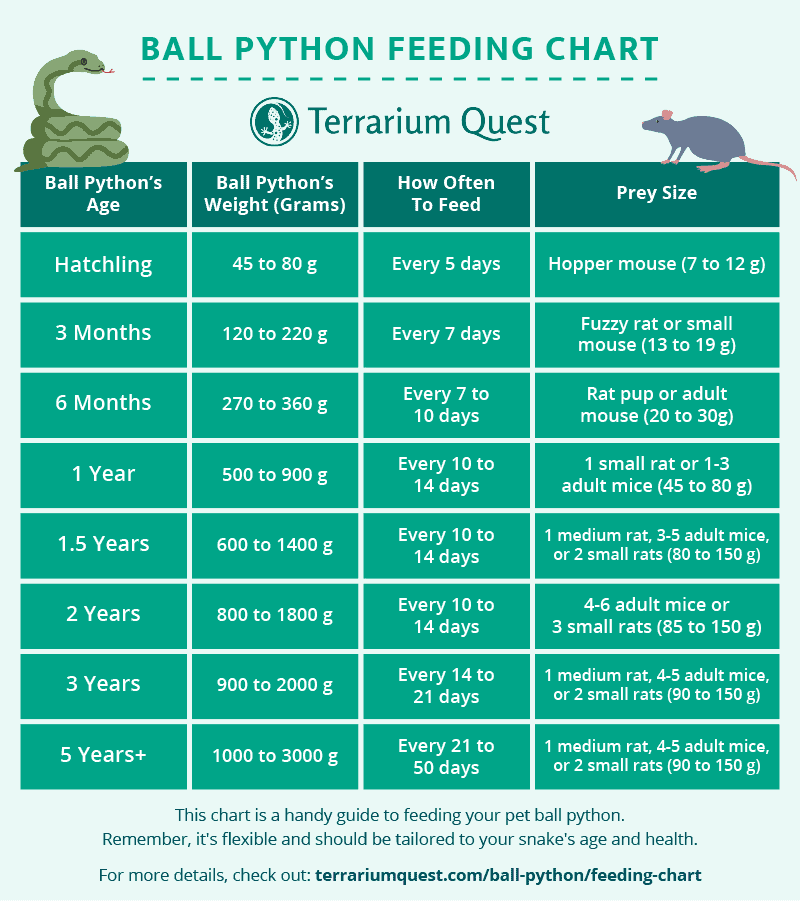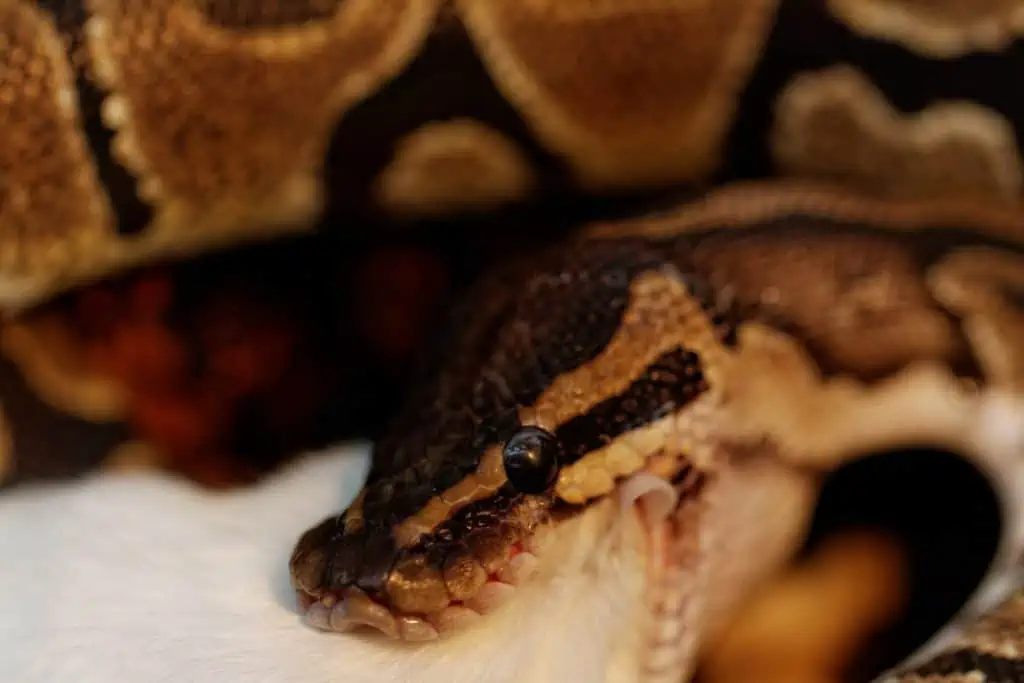Caring for your python properly means understanding the importance of nutrition and having an established feeding schedule. Ball pythons, one of the most popular snakes among hobbyists and seasoned herpetologists alike, rely heavily on proper diet to ensure long-term health. Feeding charts are a crucial tool for all ball python owners, regardless of their experience level.
They aid in comprehending the connection between snake size, age, and prey and provide invaluable insight into proper herpetoculture care to ensure that your pet receives the correct amount of food in an organized way.
Generally, ball pythons need food far less frequently than other pets.
- Feed juvenile and smaller ball pythons (0-6 months old) every 5-10 days.
- Conversely, feed sub-adult and adult ones (t to 2 years old) every 10-14 days.
- For mature ball pythons (3-5+ years old), provide food once in 2-3 weeks or even after 50 days if offering a larger meal.
Feeding your ball python appropriately will help ensure its health, growth, and overall satisfaction.
This article will explore the optimal nutrition for your ball python, what to offer as food, when to feed it, and how much is necessary. Additionally, we’ll discuss which type of prey – live or frozen – provides the best sustenance for your pet.
What To Feed Ball Pythons?
Ball pythons, native to Central Africa and West, are carnivorous creatures that consume birds or mammals small enough for them to swallow. Interestingly, the type of prey they eat varies between males and females; while Males hunt mainly on tree branches making birds their main diet source, Females spend most of their time on land, preying mostly upon mammals.
In the wild, ball pythons mostly prefer:
- Black rats
- Grass mice
- African soft-furred rats
- African giant rats
- Rufous-nosed rats
- Weaver birds
- Gerbils
- Young guinea pigs
- Young rabbits
- Hamsters
- Chicks
- Quail chicks
A ball python’s primary diet should consist of mice and rats, but providing a variety of other food sources – such as chicks, quail, or young rabbits – will ensure your pet receives all the essential nutrients it needs.
When Is the Best Time To Feed a Ball Python? Day or Night?
Pythons are nocturnal by nature. They will not eat during daylight hours. Instead, provide your pet with its meal in the dark – when it becomes active and is most likely to be interested in eating. This usually occurs towards the end of the day; once twilight or sunset has come, you can offer food and watch as your slithery friend eagerly enjoys a hearty snack!
What’s the Correct Ball Python Food Size?
When selecting suitable prey for your snake, size matters! It should be no bigger than its stomach can handle. I recommend selecting a food item that’s 1 to 1.25 times the diameter of its midsection.
Additionally, some veteran enthusiasts also suggest feeding prey up to one and a half times larger than your snake’s middle area!
If your snake is presented with too large prey, it will most likely reject the food and may even vomit it back out. Although this phenomenon isn’t common, feeding a sizeable meal to your reptile can damage its digestive system over time.
What Not To Feed a Ball Python?
Avoid feeding any wild-captured rats or mice to your ball python, as they could spread fleas and ticks. Moreover, these critters can be pretty aggressive and might hurt or even instill fear in your beloved pet snake. Unlike other kinds of snakes, ball pythons don’t tend to eat snacks like:
- Amphibians
- Eggs
- Fish
- Insects
- Large mammals
- Other reptiles
Do Ball Pythons Need Supplements?
Unlike many pet reptiles, healthy ball pythons do not require extra vitamin or mineral supplements thanks to their prey items; mice and rats provide the necessary vitamins and minerals from their bones, organs, etc.
That said, I urge pet parents to dust a few feedings in between with calcium or a multivitamin powder, as lab-raised rodents aren’t always as nutritious compared to wild ones.
Additionally, if you don’t use UVB lighting for your cage environment, adding some Vitamin D3 & Calcium would benefit your snake.
Ball Python Feeding Chart: How Much To Feed?
The feeding regimen for juvenile ball pythons is drastically different from their adult counterparts. This is due to the youth’s need for high energy intake due to rapid body growth, as opposed to mature males who grow more slowly and require less frequent meals.
Additionally, females grow considerably bigger compared to males and thus require more food than males. Gravid females also have distinct dietary needs, thus necessitating a flexible feeding chart based on size, age, and even reproductive status.
To help you get started in providing your python with proper nutrition, here are some general guidelines regarding meal sizes according to its size/age ratio!
| Ball Python’s Age | Ball Python’s Weight (Grams) | How Often To Feed | Prey Size |
| Hatchling | 45 to 80 g | Every 5 days | Hopper mouse (7 to 12 g) |
| 3 Months | 120 to 220 g | Every 7 days | Fuzzy rat or small mouse (13 to 19 g) |
| 6 Months | 270 to 360 g | Every 7 to 10 days | Rat pup or adult mouse (20 to 30g) |
| 1 Year | 500 to 900 g | Every 10 to 14 days | 1 small rat or 1-3 adult mice (45 to 80 g) |
| 1.5 Years | 600 to 1400 g | Every 10 to 14 days | 1 medium rat, 3-5 adult mice, or 2 small rats (80 to 150 g) |
| 2 Years | 800 to 1800 g | Every 10 to 14 days | 4-6 adult mice or 3 small rats (85 to 150 g) |
| 3 Years | 900 to 2000 g | Every 14 to 21 days | 1 medium rat, 4-5 adult mice, or 2 small rats (90 to 150 g) |
| 5 Years+ | 1000 to 3000 g | Every 21 to 50 days | 1 medium rat, 4-5 adult mice, or 2 small rats (90 to 150 g) |
Feeding a Breeding Male
For breeding males, mating is the only activity that requires energy. Thus, a slight adjustment in their feeding schedule may be necessary to provide them with sufficient sustenance for these activities.
When used infrequently – such as once per occasion – there should be no need to adjust his regular meals; however, if he mated with more than two females over an extended period of time (e.g., several days or weeks), then I urge you increase his meals every 14 days during this stretch. It will ensure he has enough fuel and stamina for successful matings.
Feeding a Breeding Female
Breeding female ball pythons require a hefty amount of sustenance before laying eggs, as they do not eat while incubating. Feed your gravid python with a large rat once weekly from the moment she begins to ovulate until the egg-laying process is complete.
Additionally, keep providing her food for as long as she will accept it so that her ideal weight can be maintained; this helps build fat reserves, which sustain them after delivering eggs and during their time guarding them.
I suggest pet owners ensure she weighs in at least 1,500 grams before commencing breeding endeavors!
How Long Can Ball Pythons Go Without Eating?
Ball pythons are notorious for refusing food and can go without eating for up to 3-4 months. In fact, they can even survive a year and a half with no sustenance before returning to their regular diet!
This is usually normal if your ball python has not eaten for a few weeks. But if it’s been more than 2-3 months since they last had an appetite or there is noticeable weight loss of up to 5-10% of body weight, immediately consult your vet.
What’s Better Live or Frozen Food?
For ball python owners, feeding options are twofold: with live or pre-killed prey. Many newbies opt for the former because it feels more natural; however, placing mice and rats in close quarters together poses a serious risk to your reptile friend.
As such, I highly recommend utilizing frozen rodents instead – it is safer for your snake and much easier on you! Of course, snake keepers have used both methods, yet pre-killed prey reigns supreme when considering safety and convenience.
You can find pre-killed frozen prey at most pet stores – all you need to do is defrost it before serving.
How Do You Feed a Ball Python Frozen Food?
Although ball pythons can easily adapt to frozen-thawed prey, those that have previously devoured live prey may require some time to adjust.
- Allow your prey/rat to thaw in the refrigerator for five hours (mice require only two) before serving it as a meal.
- Another option is to place the frozen rodents in your refrigerator overnight for safe thawing. Do NOT attempt to defrost a rat quickly with microwaving, as this could result in an explosive situation or uneven heating.
- Once the prey is fully thawed, enclose it in a plastic bag for optimal safety.
- Soak the plastic bag in warm water until it reaches a temperature of 110°F.
- Thoroughly dry the rat.
- Leverage soft tongs to carefully pick up the rat by its tail and offer it to your snake. This way, you avoid having your hand linked with feeding in your reptile’s mind, plus you’ll have extra space if the strike isn’t successful.
- As an alternative, you can lay the heated rodent on the bottom of its tank.
- It is best to clear any uneaten prey after 12 hours.
- If the prey is not devoured within twelve hours, promptly remove it.
How Do You Feed a Ball Python Live Food?
This method should be used as a final option. While feeding live prey to your snake is doable with proper precautions, there are still numerous risks associated with it. To feed live prey to your ball python:
- Select a rat that is smaller than the diameter of your python.
- Ensure the rat is healthy and doesn’t have any ailments or parasites.
- Utilize a sharp instrument to open the head of your prey and let its brain’s aroma drift toward your snake.
- Gently grasp the rat’s tail with tongs and lift it up.
- Gently lift your python’s lid or the top of its feeding tub and dangle the rat in front of your pet.
- Under no circumstances should you release a rat in your snake’s habitat or let it loose on it.
Feeding Tips and Mistakes To Avoid
Neglecting to provide proper nourishment for your ball python can lead to disastrous consequences. To ensure that your ball python gets the best care, it is important to avoid these common feeding mistakes made by novice owners.
- Vigilance is key when handling prey items: be sure to cleanse your hands both before and after, as well as utilize feeding tools (tongs) that are a minimum of 15″ (38 cm) long.
- Thoroughly warm and dry a mouse or rat before offering it as food.
- Once your snake has done its work, give it some privacy. Some ball pythons don’t appreciate being observed as they consume their food.
- Allow your ball python at least 2-3 days to digest its food before handling.
- To prevent obesity and ensure a longer life for your snake, refrain from providing more than one meal per week. Power feeding should be avoided at all costs!
- Refrain from providing food to your shedding ball python.
- Never force-feed your ball python. Doing so can cause serious health problems and must be avoided at all costs.
If your ball python’s habitat is not regulated at an optimal temperature, it may refuse to consume its food. Too hot or too cold can be detrimental and cause them to go off their feed.
Final Thoughts
Feeding your ball python is essential for its health and happiness. A consistent diet of the appropriate type and size will ensure your pet’s long, healthy life. Whether it’s frozen-thawed prey or live food, make sure it’s sized correctly for them – too large, and they won’t be able to eat it comfortably. With a bit of practice, you can create the perfect feeding schedule that works with their lifestyle and needs.
The key to successful feeding is consistency – pay attention to what you feed them and when, and stick to it! Doing so will ensure your ball python remains healthy and happy for years to come.
How often do you feed your ball python? What kind of food do you provide it? Let us know in the comments below!






9 Comments
I noticed in the live-feeding instructions the suggestion of “braining” the rat before feeding. I think the rat should be dead before “braining” as performing that on a living rat could be inhumane as well as unethical.
The entirety of the rest of the article is great, well-researched, and very helpful.
Hi Cassandra,
You’re absolutely right that euthanizing the mouse humanely before offering it is always the most ethical option. “Braining” a live animal is indeed inhumane and should be avoided unless there are absolutely no other alternatives.
Even then, the legality of this practice can vary, it’s important to research local animal welfare guidelines, depending on your region.
I mentioned this method only as a last resort for extreme cases where a ball python refuses all other feeding methods for extended periods. Offering live prey still carries risks that must be carefully considered, and ideally, a vet should be consulted about how best to handle a prolonged refusal to eat.
While ball pythons in the wild do consume live prey, our captive-bred snakes sometimes need additional guidance.
In these desperate situations, it can sometimes feel better to utilize this method than to see your beloved pet potentially starving to death.
I remember having a ball python who went off feed for six months! I tried everything, and it was so stressful. Out of desperation, I finally did offer a live feeder…and he ate it. It wasn’t the ideal situation by any means, but seeing him healthy again was such a relief.
Great article! I’ve had Kit for over a year but still consider myself a newbie. Regarding the chart, I’ve basically followed the frequency. ( feed thawed out mice). But, we thought you got the correct size mouse and fed only one per feeding. It looks like at approximately 1.5 years, I should be feeding 3 or 4 mice per feeding. Is that correct?
Thanks so much.
Hi Korrie,
You’re absolutely correct – as ball pythons mature, you may need to offer multiple mice per feeding to ensure they’re getting adequate nutrition.
Since Kit is around 1.5 years old, you should give 3-4 mice or 100 – 150 gram rat per feeding would be a good starting point. Observe how Kit handles that amount, and if needed, you can slightly increase or decrease the number of mice offered to better suit their individual needs.
Thank you very much for the feeding chart I own a 3yr old male Ball and my female is a little over a yr old, hard times got me kind of behind on feeding my female so she is still kind of small should I go ahead and feed her like every 7 days until she catches up on her weight? Also I have them hooded together right now it doesn’t stress them out they seem to love each other but I’m afraid of my male trying to mate with my female ass she is too young, do the snakes biological know when they should mate? I worry about this or should I separate them as soon as possible? I’m in the hospital for the next month they are here with me so I can’t separate them until the first week of March unless I can get someone to bring me 2 habitats for them… Please let me know your thoughts on this as you seem to know a lot about Balls. I do plan to mate them when Bella is 3yrs old and although my Slitherz is 3yrs old now will be be alright to mate with her in 2yrs?? Thank you very much for your time and response on this matter.
Hi Britt,
Underfeeding can definitely impact growth, so getting your female on a more regular feeding schedule is important. Feeding her every 7 days would be a good start to help her catch up to a healthy weight. Make sure the prey items you offer are appropriately sized for her current weight – approximately 10-15% of her body weight is a good guideline.
Male ball pythons usually mature faster than females. Even though your male is ready for breeding, it’s absolutely essential to wait until your female is both around 2-3 years old and weighs at least 1200 grams before considering breeding. This ensures her health and the well-being of any offspring.
About cohabitating, it’s still strongly recommended that you separate your snakes immediately. Ball pythons are solitary animals and keeping them together can cause stress, injuries, and even cannibalism. Snakes don’t have social needs like humans and won’t miss each other. While they may appear content now, the underlying stress will likely have negative consequences. Since they can’t be separated for a while, monitor them closely for any signs of discomfort.
I hope this helps!
I was feeding my ball python about once every 4 days. I have a rather large terrarium and would just place it in there and then let time take place and the snake would usually chase the mouse down rather fast. I assumed that since he was so quick to find it and eat it on his own that the schedule was good. Should I slow it down to only once per week?
Hi Brandy,
It’s great that you’re attentive to your ball python’s feeding patterns. The feeding frequency indeed depends on the age and size of your snake. Typically, younger pythons (0-1 years old) are fed once every 5-7 days, while pythons (up to 2 years old) are fed every 10-14 days. As they mature (3 years and older), the frequency reduces to once every 2-3 weeks or even longer with larger meals
Given your python’s keenness to eat every 4 days, it might be younger or have a faster metabolism. However, it’s advisable to gradually transition to a weekly feeding schedule as it matures, which seems to align well with common recommendations. Monitoring its weight and consulting with a vet can also provide personalized advice based on its health and growth.
P.S. It’s great that you have a spacious terrarium for your python to explore and exercise in. This environment will surely contribute positively to its overall well-being. Keep up the great care!
Great article! As a new ball python owner, I found this feeding guide very helpful. Establishing a proper feeding routine can be tricky with ball pythons, since they are prone to going off feed. The chart provides a clear schedule to follow based on the snake’s age and weight. I also appreciate the tips on getting picky eaters to eat again. The suggestion to try braining the mouse or warming it up more is something I will definitely try if my ball python starts refusing food. Thanks for providing such a detailed guide! This will be a valuable resource for me as I start feeding my new snake.